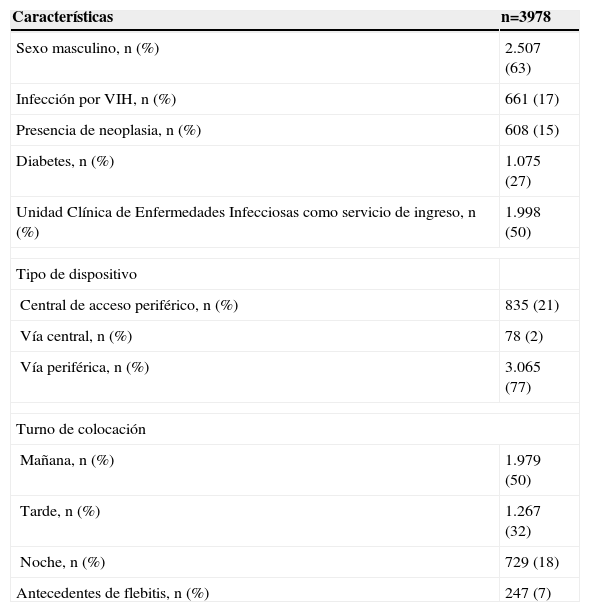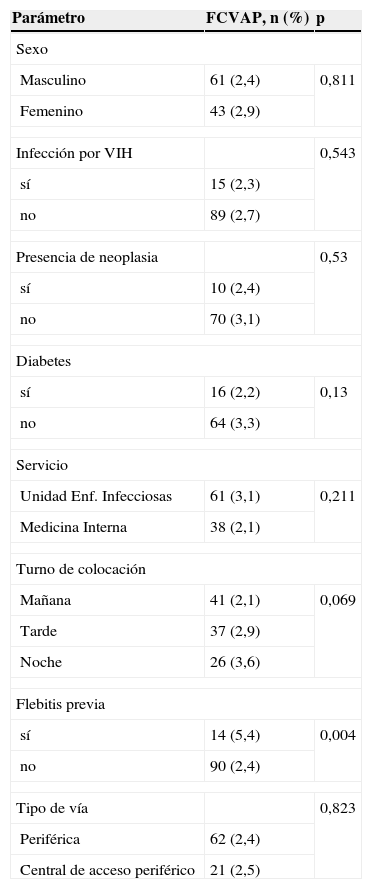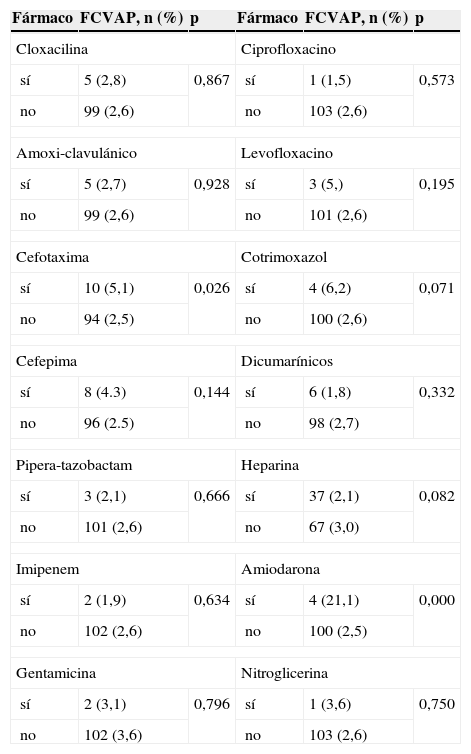Evaluar el impacto de un protocolo de manejo de catéteres sobre la incidencia de flebitis causadas por catéteres venosos de acceso periférico (FCVAP) y analizar los factores relacionados con su desarrollo en pacientes hospitalizados.
MétodoDesde septiembre de 2002 hasta diciembre de 2007 se incluyeron prospectivamente 3.978 episodios de canalizaciones venosas. Se implantó progresivamente un protocolo de manejo de catéteres, se determinó la incidencia de FCVAP y se analizaron las variables asociadas a su desarrollo.
ResultadosLa incidencia de FCVAP fue 4,8%;4,3%;3,6%;2,5%;1,3% y 1,8% desde 2002 hasta 2007 (p<0,001). Para vías periféricas, amiodarona (Odds ratio ajustada [ORA] 25,97; IC del 95%: 7,29–92,55, p=0,0001), cefotaxima (ORA 2,90; IC del 95%: 1,29–6,52, p=0,01) y el turno de colocación de la vía (ORA para turno de mañana vs. noche 0,60; IC del 95%: 0,35–1,02, p=0,063) se asociaron independientemente con FCVAP. Para las vías centrales de acceso periférico se asoció de manera independiente con FCVAP únicamente el antecedente de flebitis (ORA 3,24; IC del 95%: 1,05–9,98, p=0,04).
ConclusionesLa aplicación de un protocolo de actuación disminuye la incidencia de FCVAP en pacientes hospitalizados. El antecedente de flebitis en las vías centrales de acceso periférico y la amiodarona o cefotaxima por vías de acceso periférico aumentan el riesgo de FCVAP. La colocación de vías periféricas en turnos de mañana se asocia con menor incidencia de FCVAP que en el turno de noche.
To assess the impact on the incidence of PPIVC by implementing a catheter management protocol and to determine risk factors for PPIVC development in hospitalized patients.
MethodA total of 3978 episodes of venous catheterization were prospectively included from September 2002 to December 2007. A catheter management protocol was implemented during this period of time. The incidence and variables associated to the occurrence of PPIVC were determined.
ResultsThe incidence of PPIVC from 2002 to 2007 was 4.8%, 4.3%, 3.6%, 2.5%, 1.3% and 1.8% (p<0.001). Perfusion of amiodarone [adjusted OR (AOR) 25.97; 95% CI=7.29–92.55, p=0.0001] and cefotaxime (AOR 2.90; 95% CI=1.29–6.52, p=0.01) and the shift when the catheters were placed (AOR for morning vs. night shift 0.60; 95% CI=0.35–1.02, p=0.063) were independently associated to the development of PPIVC. A history of phlebitis was the only factor independently associated to phlebitis due to peripherally inserted central venous catheters (AOR 3.24; CI at 95% CI= 1.05–9.98, p=0.04).
ConclusionsA catheter management protocol decreases the incidence of PPIVC in hospitalized patients. The risk of PPIVC increases for peripherally inserted central venous catheters when the patients have a history of phlebitis and for peripheral venous catheters when amiodarone or cefotaxime are infused. Catheterization of peripheral veins performed during morning shifts is associated with a lower incidence of PPIVC when compared with night shift catheterizations.
Artículo
Comprando el artículo el PDF del mismo podrá ser descargado
Precio 19,34 €
Comprar ahora










